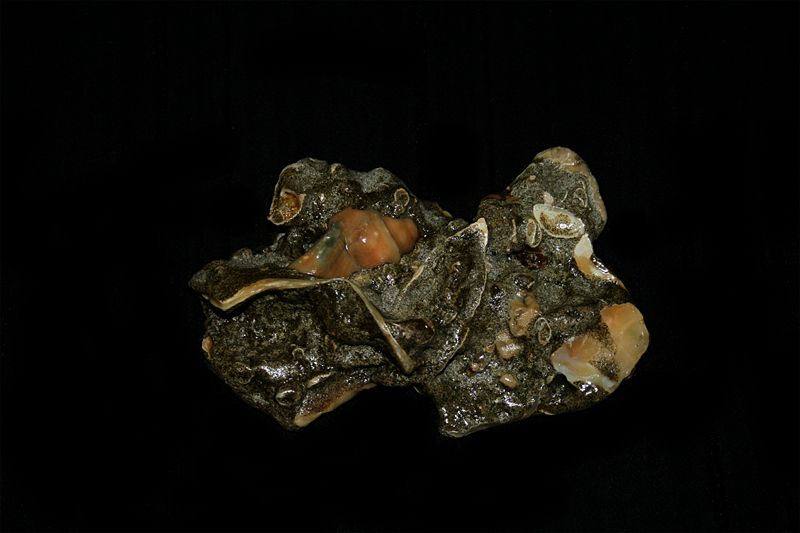What is Sandstone?
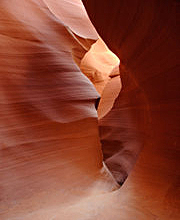 Sandstone worn smooth
Sandstone worn smooth Sandstone
is a sedimentary rock composed mainly of sand-size mineral or rock grains. Most sandstone is composed of quartz and/or feldspar because these are the most common minerals in the Earth's crust. Like sand, sandstone may be any color, but the most common colors are tan, brown, yellow, red, gray and white. Since sandstone beds often form highly visible cliffs and other topographic features, certain colors of sandstone have been strongly identified with certain regions. Some sandstones are resistant to weathering, yet are easy to work. This makes sandstone a common building and paving material. Because of the hardness of the individual grains, uniformity of grain size and friability of its structure, sandstone is an excellent material from which to make grindstones, for sharpening blades and other implements. Non-friable sandstone can be used to make grindstones for grinding grain, e.g., gritstone. Rock formations that are primarily sandstone usually allow percolation of water and are porous enough to store large quantities, making them valuable aquifers. Fine-grained aquifers, such as sandstones, are more apt to filter out pollutants from the surface than are rocks with cracks and crevices, such as limestones or other rocks fractured by seismic activity
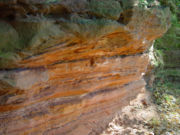 Sandstone near Stadtroda, Germany
Sandstone near Stadtroda, GermanyThe formation of sandstone involves two principal stages. First, a layer or layers of sand accumulates as the result of sedimentation, either from water (as in a river, lake, or sea) or from air (as in a desert). Typically, sedimentation occurs by the sand settling out from suspension, i.e., ceasing to be rolled or bounced along the bottom of a body of water (e.g., seas or rivers) or ground surface (e.g., in a desert or sand dune region). Finally, once it has accumulated, the sand becomes sandstone when it is compacted by pressure of overlying deposits and cemented by the precipitation of minerals within the pore spaces between sand grains. The most common cementing materials are silica and calcium carbonate, which are often derived either from dissolution or from alteration of the sand after it was buried. Colors will usually be tan or yellow (from a blend of the clear quartz with the dark amber feldspar content of the sand). A predominant additional colorant in the southwestern United States is iron oxide, which imparts reddish tints ranging from pink to dark red (terra cotta), with additional manganese imparting a purplish hue. Red sandstones are also seen in the Southwest and West of England and Wales, as well as central Europe and Mongolia. The regularity of the latter favors use as a source for masonry, either as a primary building material or as a facing stone, over other construction.
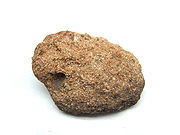 Millet-Seed Sandstone Macro (~ 4 cm)
Millet-Seed Sandstone Macro (~ 4 cm)Origins of Sandstone
Sandstones are clastic in origin (as opposed to organic, like chalk and coal, or chemical, like gypsum and jasper). They are formed from cemented grains that may either be fragments of a pre-existing rock or be mono-minerallic crystals. The cements binding these grains together are typically calcite, clays and silica. Grain sizes in sands are in the range of 0.1 mm to 2 mm (clays and rocks with smaller grain sizes including siltstones and shales are typically called argillaceous sediments; rocks with larger grain sizes including breccias and conglomerates are termed rudaceous sediments).
The environment where it is deposited is crucial in determining the characteristics of the resulting sandstone, which, in finer detail, include its grain size, sorting and composition and, in more general detail, include the rock geometry and sedimentary structures. Principal environments of deposition may be split between terrestrial and marine, as illustrated by the following broad groupings:
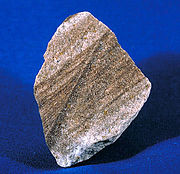 Quartz Sandstone
Quartz SandstoneOnce the geological characteristics of a sandstone have been established, it can then be assigned to one of three broad groups:
- arkos or arkosic sandstones, which have a high (>25%) feldspar content and a composition similar to granite.
- quartzose sandstones, also known as "beach sand", which have a high (>90%) quartz content. Sometimes these sandstones are termed "orthoquartzites", e.g., the Tuscarora Quartzite of the Ridge-and-valley Appalachians.
- argillaceous sandstones, such as greywacke or bluestone, which have a significant clay or silt content.
According to the USGS, U.S. sandstone production in 2005 was 192,000 metric tons worth $24.3 million, the largest component of which was the 121,000 metric tons worth $9.75 million of flagstone or dimension stone
Gallery
 Sandstone
Sandstone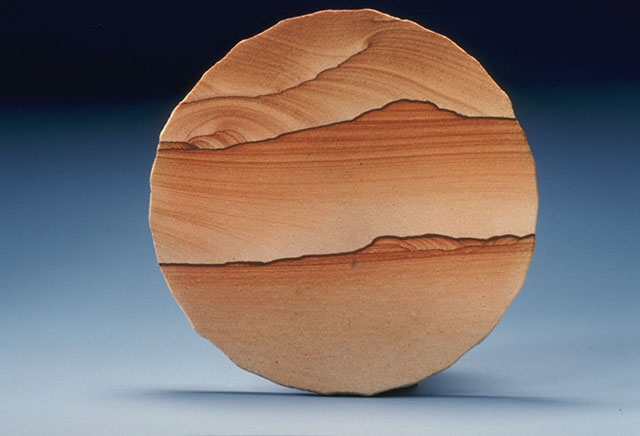 Prepared sample of sandstone
Prepared sample of sandstone Chamber wall in Petra
Chamber wall in Petra Sandstone formation, Eilat Massif, Israel.
Sandstone formation, Eilat Massif, Israel. Modern residence with sandstone external veneer.
Modern residence with sandstone external veneer. Sandstone building in Sydney, Australia
Sandstone building in Sydney, AustraliaReferences
- Boggs, J.R., 2000, Principles of sedimentology and stratigraphy, 3rd ed. Toronto: Merril Publishing Company. ISBN 0-13-099696-3
- Folk, R.L., 1965, Petrology of sedimentary rocks PDF version. Austin: Hemphill’s Bookstore. 2nd ed. 1981, ISBN 0-914696-14-9
- Pettijohn, F.J., P.E. Potter and R. Siever, 1987, Sand and sandstone, 2nd ed. Springer-Verlag. ISBN 0-387-96350-2
- Scholle, P.A., 1978, A Color illustrated guide to constituents, textures, cements, and porosities of sandstones and associated rocks, American Association of Petroleum Geologists Memoir no. 28. ISBN 0-89181-304-7
- Scholle, P.A., and D. Spearing, 1982, Sandstone depositional environments: clastic terrigenous sediments , American Association of Petroleum Geologists Memoir no. 31. ISBN 0-89181-307-1
- USGS Minerals Yearbook: Stone, Dimension








